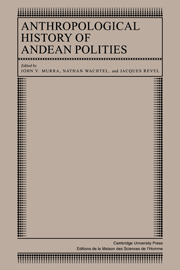Book contents
- Frontmatter
- Contents
- List of contributors
- Preface
- Introduction
- Part I Ecology and society
- Part II The ethnic group and the state
- 4 The expansion of the Inka state: armies, war, and rebellions
- 5 Storage, supply, and redistribution in the economy of the Inka state
- 6 The extraction of precious metals at the time of the Inka
- 7 Vertical politics on the Inka frontier
- Part III Systems of classification
- Part IV Symbolic representations and practices
- Part V From ethnic polities to communities
- Bibliography of published source
- Index
7 - Vertical politics on the Inka frontier
Published online by Cambridge University Press: 05 October 2010
- Frontmatter
- Contents
- List of contributors
- Preface
- Introduction
- Part I Ecology and society
- Part II The ethnic group and the state
- 4 The expansion of the Inka state: armies, war, and rebellions
- 5 Storage, supply, and redistribution in the economy of the Inka state
- 6 The extraction of precious metals at the time of the Inka
- 7 Vertical politics on the Inka frontier
- Part III Systems of classification
- Part IV Symbolic representations and practices
- Part V From ethnic polities to communities
- Bibliography of published source
- Index
Summary
What happened within aboriginal Andean societies after Tawantinsuyu overpowered them? Chronicles transmit to us the Inkas’ own answers, emphasizing the state's largesse and civilizing influence, the teaching of Inka cults, and the establishment of idealized political structures in the likeness of Cusco. But in these accounts two crucial questions go unanswered. First, what kind of societies did the Inka propose to transform? Their habit of dismissing subject societies as barbarian behetrías prior to conquest makes it difficult to tell whether they were fundamentally similar in political makeup to central Andean communities or qualitatively different. Second, by what concrete series of interventions, incentives, and manipulations did the Inkas set about recasting the aboriginal formations in the image of a uniformizing structure? The ideal form of the “Fourfold Domain,” seemingly rigid and abstract, must in some way have provided a realistic guide to the problem of dealing with thousands of more or less refractory local ethnic lords, yet we do not know in terms of historical process how it was done.
These problems should be especially interesting at the extreme frontiers of the empire, where Tawantinsuyu subjected peoples who had adapted to ecological conditions different from those that shaped Cusco, and whose ancestors had been relatively little affected by earlier waves of Andean empire building. Araníbar (1969–70) has suggested that the northern Inkaic periphery may have conserved archaic cultural complexes lost in the central Andes and thus could afford a clue to cultural elements older than the Andean states. The problem should also be especially accessible at the peripheries, because when Tawantinsuyu was decapitated, it left its work there in various stages of incompletion.
- Type
- Chapter
- Information
- Anthropological History of Andean Polities , pp. 89 - 118Publisher: Cambridge University PressPrint publication year: 1986
- 18
- Cited by



